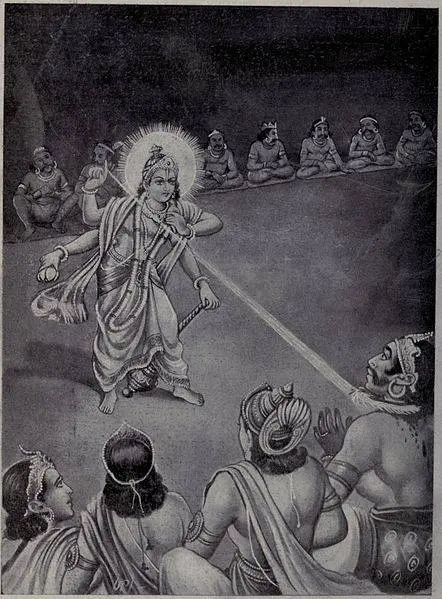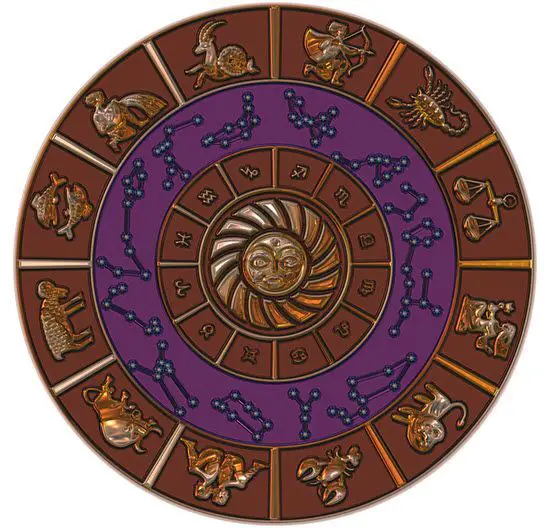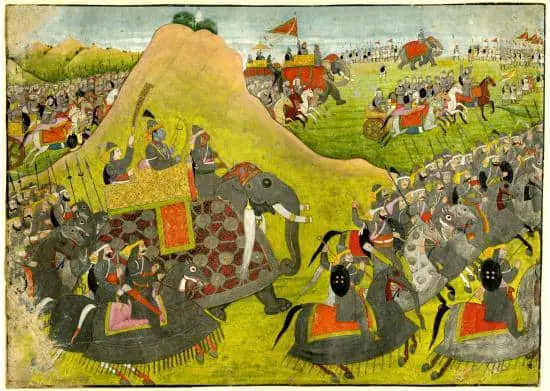Rahu Kaal is one of the most feared aspects of Indian astrology.
As per Indian astrology, Rahu Kaal is specific 1/8th daytime part of the weekdays which is said to be ruled by the evil planet Rahu – the Lunar Node.
Simply put, Rahu Kaal is the specific period of about one hour and thirty minutes during the day (between Sunrise and Sunset) which is governed by Rahu.
So, Rahu Kaal is the bad time in a day.
It is a very inauspicious time of the day.
It is assumed to be highly malefic, and people do not initiate any activity whatsoever during the Rahu Kaal.
Any work started in Rahu Kaal does not yield a good result.
So, people avoid new work, a new journey, marriage, business dealings, sale/purchase, and even trade-related activities during the Rahu Kaal. Moreover, no auspicious ventures get started when the Rahu Kaal prevails.
Table of Contents
Role of Rahu in Vedic Astrology
Rahu has been accorded an imaginary point in the sky.
It has no physical shape.
However, the Vedic Rishis and Seers have allotted Rahu the status of a planet.
Rahu is considered the most powerful and confers malefic effect.
It is considered an evil planet and indicates laziness, filthiness, delays, and hurdles.
Rahu stays for a period of 18 months in a zodiac sign.
The Hindu mythology describes an interesting episode of how Rahu came into existence.
Once the gods and the demons agreed to churn the mighty oceans to produce nectar that could give them immortality.
After the churn when the nectar was served to the Gods, Rahu disguised himself as a God and sat in between the Sun and the Moon so that he may consume the nectar and become immortal.
However, the Sun and the Moon recognized the demon and complained to Lord Vishnu.
The Lord Vishnu immediately detached his head with his Sudarshan Chakra. However, the demon had consumed enough nectar to make him immortal.
The head of the demon became to be known as “Rahu,” and the remaining corpse was known as “Ketu.”
Ever since then, Rahu and Ketu became the strong enemy of Sun and Moon. In fact, the Sun and Moon eclipses occur due to Rahu and Ketu who take their revenge from Sun and Moon.
In Vedic astrology, Rahu is called the North Lunar Node, and Ketu is called the South Lunar Node.
Hindu Astrology confers Rahu as a malefic planet.
He is extraordinarily powerful and has a snakelike, half-bodied figure. It is regarded as a shadow planet.
He rules over thieves, jails, magicians, snake, poison, and isolated places.
Negative placement of Rahu in one’s horoscope can create confusion, depression, and emotional imbalances.
However, Rahu is a favorable planet for the politicians.
Rahu gives great power and opportunity to rise in politics through fair or unfair means.
Rahu can also confer sudden wealth.
The Rahu becomes powerful when placed in the 3rd, 6th, or 11th house of a horoscope.
In general, people are afraid of Rahu and Rahu Dasha.
Rahu is counted as one of the nine planets. Rahu is friend with Mercury, Venus, and Saturn.
It is neutral to Jupiter. Rahu is enemy to Sun, Moon, and Mars.
Rahu is considered more powerful than the Sun.
The Rahu is the Karaka planet for strategies and politics.
It governs the south-west direction of your house.
Rahu bestows knowledge, intelligence, and speech.
It is Karaka for foreign travel, computers, work related to electronics, research, and new inventions.
Rahu is associated with materialistic things, aggressive nature, gambling, and theft.
It is also associated with feet, respiratory system, baldness, aging, skin diseases, pain and swellings, bad smell, and anger.
Rahu is also responsible for bacterial diseases in our body.
Rahu Dasha prevails for 18 years.
According to Vastu Shastra, the southwest corner of the house or building is governed by Rahu.
The defects or Dosha in the southwest corner may give rise to relationship problems, financial difficulties and loss of business.
One can get over the ill effects of Rahu by worshiping Lord Shiva and Maa Durga.
What is Rahu Kaal?
Rahu Kaal has been derived from the Vedic Muhurta Astrology.
It’s an important terminology that is prevalent in the Hindu Vedic tradition.
As per Hindu astrology, the planet Rahu is considered an evil planet. Hence, when the transition of Rahu occurs during the day, it should be avoided for any auspicious or new works.
The transition of Rahu between Sunrise and Sunset determines the Rahu Kaal. It is 1/8th part of the day between sunrise and sunset.
People avoid doing any auspicious work during this period of the day.
In fact, the Rahu Kaal is one of the most feared aspects in the Hindu Astrology. Moreover, millions of hours are wasted in fear of the Rahu Kaal. People enter a state of “no action” during this period.
Nowadays, most of the local newspapers do mention the Rahu Kaal duration for each day of the week for the guidance of their readers.
Rahu Kaal and Panchang
The Panchang denotes the timing of the Rahu Kaal.
However, there are many Panchangs in India prevailing in different parts of the country.
Although the Rahu Kaal is for one and half hours every day, however, it is little changeable from one place to another.
So, you have to follow the local Panchang to determine the exact time of Rahu Kaal in your city.
The local Panchang considers not only Indian Standard Time but also Local Mean Time.
By following the local Panchang, you can come to know the exact Rahu Kaal time in your city.
Duration of Rahu Kaal
Now, you know that the length of Rahu Kaal is 1/8th part (Yamardha) of daytime length which is about one and half hours.
Daytime is specific to a place and is considered the length of time from Sunrise to Sunset.
Here, we want to let you know a very important fact about Rahu Kaal. In fact, on different weekdays different portions of daytime are allocated to Rahu Kaal.
Rahu Kaal Duration
Rahu Kaal on Mondays is 2nd Yamardha.
It is 3rd Yamardha on Saturday.
It is 4th Yamardha on Friday.
5th Yamardha on Wednesday, 6th on Thursday, 7th on Tuesday, and 8th (the last Yamardha) on Sunday determine the Rahu Kaal.
Let us clarify it for you.
Let’s take the Rahu Kaal on Mondays which is 2nd Yamardha.
It means that after the expiry of the first 1/8th part of the daytime, after the local Sunrise, Rahu Kaal begins, and ends at the expiry of the second 1/8th part of the local daytime.
So, if the Sunrise is taken to be at 6:00 AM, the Rahu Kaal for different weekdays will be as follows:
- Monday – 07:30 AM to 09:00 AM (Standard Time)
- Saturday – 09:00 AM to 10:30 AM (Standard Time)
- Friday – 10:30 AM to 12:00 AM (Standard Time)
- Wednesday – 12:00 AM to 1:30 PM (Standard Time)
- Thursday – 1:30 PM to 3:00 PM (Standard Time)
- Tuesday – 3:00 PM to 4:30 PM (Standard Time)
- Sunday – 4:30 PM to 6:00 PM (Standard Time)
The newspapers follow the above system. They publish the Rahu Kaal for the guidance of the users.
How is Rahu Kaal Calculated?
There’s little astrological arithmetic behind the Rahu Kaal calculation. The calculation is done considering 12 hours between sunrise and sunset. The 12 hours are divided into eight parts which come to 1.5 hours.
So, if the Sunrise is at 6:00 AM and Sunset at 6:00 PM:
The 1st Yamardha is from 6:00 AM to 7:30 AM.
The 2nd Yamardha is from 7:30 AM to 9:00 AM.
The 3RD Yamardha is from 9:00 AM to 10:30 AM.
The 4th Yamardha is from 10:30 AM to 12:00 AM.
The 5th Yamardha is from 12:00 AM to 1:30 PM.
The 6th Yamardha is from 1:30 PM to 3:00 PM.
The 7th Yamardha is from 3:00 PM to 4:30 PM.
The 8th Yamardha is from 4:30 PM to 6:00 PM.
For example, on Sundays, the Rahu Kaal sets in with the 8th Yamardha. So, the Rahu Kaal timings on Sunday are from 4:30 PM to 6:00 PM.
However, the exact Rahu Kaal timings for a given place depend upon the local time. So, you need to refer to the local Panchang to find out the Rahu Kaal in your city or town.
Rahu Kaal Mnemonics
The Rahu Kaal timings can be very tricky to remember for different weekdays. Most of the people face difficulty in remembering the Rahu Kaal timings every day.
So, here’s a little help for you to memorize this critical calculation.
Herein, we put across to you Rahu Kaal Mnemonics.
The mnemonic is “7:30 Mother Saw Father Wearing the Turban Suddenly.”
Here’s how it can help you:
- Mother = Monday (7.30-9.00)
- Saw = Saturday (9.00-10.30)
- Father = Friday (10.30-12.00)
- Wearing = Wednesday (12.00-13.30)
- The = Thursday (13.30-15.00)
- Turban = Tuesday (15.00-16.30)
- Suddenly = Sunday (16.30-18.00)
Concluding
The Vedic Astrology reckons the Rahu Kaal as a very malefic period of the day.
The Rahu Kaal is under the influence of the evil planet Rahu.
If one performs Puja, Hawan, or Yagya during the Rahu Kaal then desired results are not achieved.
So, you should consider Rahu Kaal before embarking on any new work.
If you avoid the Rahu Kaal, the probability of achieving the desired results is increased.
Having said that any work related to Rahu appeases the planet and gives good results during this period.
One can perform Hawan or Yagya to propitiate Rahu during the period of Rahu Kaal.
Rahu Kaal is given due importance by Hindus especially people living in South India. They avoid doing any auspicious activities during the Rahu Kaal such as marriage rituals, purchase of gold, shares, car, starting a new business, sale/purchase, etc.
However, already started work can be continued during this period of Rahu Kaal.
Rahu Kaal is only considered for daytime as the most auspicious, and new work is started during the daytime. The Rahu Kaal is not effective during nighttime.
Rahu Kaal on Tuesday, Friday, and Sunday show more malefic effects than those of other weekdays.






